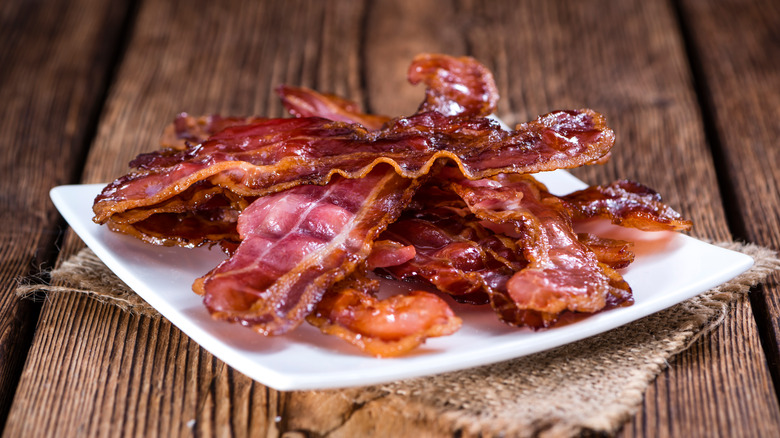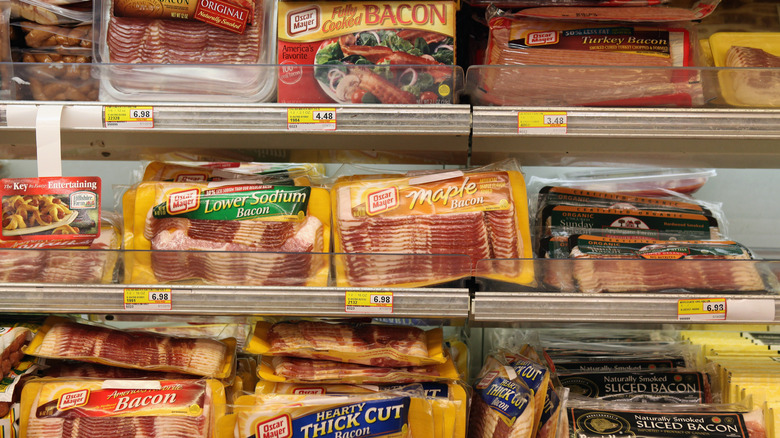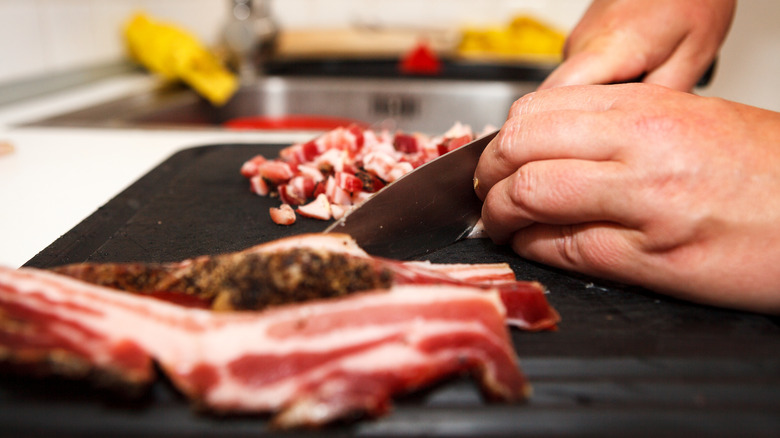What Separates Wet From Dry-Cured Bacon?
If you find the bacon section of the grocery store overwhelming, you aren't alone. Dry-cured and wet-cured are just two of the many labels you might find on packages of the meat. But don't panic, these designations are straightforward enough and will soon have you making an informed purchasing decision when it comes to bringing home the bacon.
Curing is an age-old way to keep meat delicious and safe from spoilage. It removes most of the moisture, typically through methods like smoking or drying, and adds plenty of salt to create an environment where bacteria cannot grow. This way of curing is typically how bacon is created, along with salami and prosciutto.
Dry-curing is similar to traditional techniques. Pork is rubbed with salt, seasonings, and sugar, then left to cure for days or weeks. The longer the curing time, the more intense the final flavor. This method draws out excess moisture in the meat, essentially dehydrating it. After curing is finished, what is now bacon is smoked and sliced.
Wet-curing is the method used in most grocery store bacon. Also called brining, this technique involves combining salt and seasoning with water. The pork is submerged into this mixture or injected with it. Wet-curing can take place over several hours to days, depending on how quick the absorption is. Once done, the pork is smoked or coated in liquid smoke to give it that classic rustic flavor.
What uncured means and other bacon labels to know
What about packages of bacon labeled "uncured"? According to the USDA, uncured bacon simply means that synthetic nitrates weren't used. Instead, the bacon must be labeled to inform consumers that there may be ingredients with naturally-occurring nitrates. This list includes ingredients like sea salt, parsley, or powders made with celery juice, cherries, or beets.
"Smoked" may be another term you come across frequently. As mentioned above, smoking is a staple in curing bacon (with the exception of some wet methods that use liquid smoke instead), and the type of wood used is essential for making subtle differences in the final product. Anything labeled "hardwood smoked" or "naturally smoked" doesn't specify the wood variety and just means liquid smoke wasn't used. "Hickory smoked" has that classic bacon flavor, while you can get a fruity taste from "applewood-smoked" and "cherrywood-smoked" products.
"Sugar-cured" is another frequent term. Sugar is typically a part of the bacon curing process with the salt and seasoning, so anything labeled this way is likely more of a marketing tactic to get people interested in the product. "Maple-cured" means that maple syrup was used for at least part of the sweetener during curing, which may add a hint of flavor to the end product. There is also "sugar-free" bacon, which skips on using sugar when it's cured.
Cuts of bacon and how to use them
Another defining quality about bacon is the variety of cuts available. Standard bacon is American style, roughly 1/16-inch thick, and is the traditional kind for breakfast plates or topping a burger.
Thin bacon is perfect for wrapping other foods, like jalapeño poppers or dates. Also known as "restaurant bacon," it's a mere 1/32-inches thick, meaning it crisps up easily and quickly without overcooking when it's used as a wrapper. If you're following a recipe that calls for standard bacon and you want to substitute in thin bacon, just remove a few minutes of cooking time to avoid burning the strips.
Thick bacon is on the other end of the spectrum. It is about 1/8-inch thick, or twice the width of standard bacon, and it's sturdy enough to be used in long-cooking dishes such as soups and sauces without breaking down. Thick bacon won't crisp up and it remains chewy.
Center-cut bacon is known for having 25 to 30% less fat than traditional bacon. It's made from pork belly that has the fat ends removed by cutting close to the bone. Swap it in for traditional bacon to create a leaner dish, such as in a quiche.
Slab bacon isn't cut into strips and instead is sold as one whole piece. This is typically available at the butcher counter and used in dishes where certain cuts of bacon (such as diced or cubed) are needed. Try it in carbonara or grilling a thick slice for a hearty BLT.



